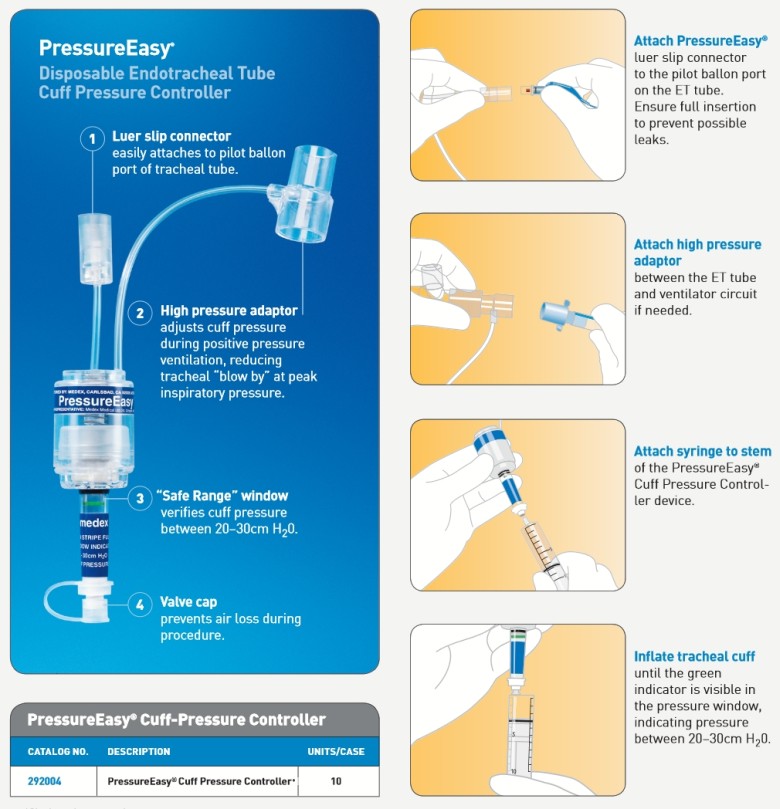 |
Veterinary Anesthesia & Analgesia Support Group |
| Practical Information for the Compassionate Veterinary Practitioner |
|
| HOME |
|
 |
|||
|
|
||||
| Bob Stein | ||||
| Udated February 2018 | ||||
Establishing endotracheal tube cuff pressure at the beginning of an anesthesia event is a challenge of its own; too little pressure and material can enter the lower airways triggering an aspiration pneumonia event; too much pressure and you could cause potentially catastrophic tracheal rupture or tracheal necrosis. Tips for maximizing your ability to provide optimal cuff pressure while minimizing the risk of patient morbidity include:
The PressureEasy attaches to the ET tube cuff valve and an adaptor that is inserted into the anesthetic system between the ET tube and the rest of the system as shown in the picture above. Air is used to inflate the ET tube cuff through the PressureEasy inflation port. Inflation continues until the green bar is visable in the PressureEasy indicator window; at this point cuff pressure should be between 20 and 30 cm water pressure. Pressure feedback helps guard against loss of cuff pressure and it helps ensure proper cuff seal when higher pressures are used during ventilation. The internal chamber provides addition cuff air as cuff pressure naturally drops during the anesthetic event. The adapter senses temporary increases in system pressure and temporarily provides additional cuff pressure to guard against leaks during short periods of higher system pressure. The PressureEasy does not mate well with all ET tube valves. For instance, the large diameter silicone tubes manufactured by Jorvet have cuff valves that are extraordinarily large, preventing their full insertion into the PressureEasy connector. In contrast, the plastice larger diameter Jorvet ET tubes mate well with the PressureEasy connector. As you can see from the pictures below, the silicone type ET tubes have a valve with much larger diameter than the plastic ET tubes. |
||||
 |
||||
| Quick overview of PressureEasy Device | ||||
|
||||
|
||||
One additional point about the Jorvet tubes: as you can see below, the silicone tubes have low volume-high pressure cuffs whereas the plastic tubes have more attractive high volume - low pressure cuffs. The upper tubes is the larger diameter Jorvet plastice ET tube. The lower tube is the larger diameter Jorvet silicone ET tube. |
||||
| You can find more PreassureEasy information from Smiths Medical if you click on these links: | ||||
| Page References: | ||||
| Laboratory evaluation of 4 brands of endotracheal tube cuff inflator. Blanch PB. Respir Care. 2004 Feb;49(2):166-73. | ||||
| Tracheal rupture associated with intubation in cats: 20 cases (1996-1998). Mitchell SL, McCarthy R, Rudloff E, Pernell RT. J Am Vet Med Assoc. 2000 May 15;216(10):1592-5. | ||||
| Tracheal rupture in cats: 16 cases (1983-1998). Hardie EM, Spodnick GJ, Gilson SD, Benson JA, Hawkins EC. J Am Vet Med Assoc. 1999 Feb 15;214(4):508-12. | ||||
| Massive surgical emphysema during the course of general anaesthesia. Barrett NR, Thomas D. Br Med J 1944;2:692–693. |
||||
| Tracheal laceration associated with endotracheal anesthesia. Kumar SM, Pandit SJ, Cohen PJ. Anesthesiology 1977;47:298–299. |
||||
| Rupture of the trachea following endotracheal intubation. Thompson DS, Read RC. JAMA 1968;203:995–997. |
||||
| Tracheal rupture, complication of cuffed endotracheal tube. Tornwall SS, Jackson KH, Oyanedel E. Chest 1971;59:237–239. | ||||
| Questions or problems regarding this web site should be directed to DRSTEIN@VASG.ORG . Copyright © 2003 ASAH. All rights reserved. Last modified: February 21, 2018 . |
||||